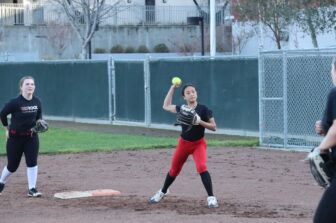

FIND THE RIGHT FIT
Once high school athletes decide they want to play in college, they begin looking at different schools and their athletic programs and coaches. Determining possible colleges and universities is rarely based on athletics alone. For most, a school’s academics, location and educational opportunities hold just as much as, if not more, weight than athletics.
“I knew for sure I want to row in college, because it’s something I really love,” explains senior lightweight rower Isabella Duan, who will be attending Stanford University next fall. “[When applying,] I identified a couple places I wanted to row at, due to the quality of their team, as well as the education at the school, and then I emailed those coaches and started talking.”
PUT YOURSELF OUT THERE
After players determine which schools they are interested in, they get in touch with coaches or a college coach approaches or “discovers” the athlete.
“For me, playing club softball helps a lot. We go to a bunch of showcases, which gives us exposure to college coaches,” says senior softball player Soraya Valdez-Frick, a Coppin State University recruit.
Showcases are tournament style events that club teams sign up for, providing the players an opportunity to demonstrate their skill in front of college coaches and scouts who attend the event. Aside from showcases, coaches may discover high school athletes through recruiting websites, such as Hudl or CaptainU, where players can create profiles with their position, team and graduation year.
“I used this website called [National Collegiate Scouting Association Athletic Recruiting],” recalls Valdez-Frick. “By going on there, I was connected to every college in the nation, so that helped a lot. Then I was paired up with an ex-collegiate player who went through the [recruiting] process and is willing to help. I had monthly check ins with them on the phone, or [via] email … it was really helpful.”
The more common way to get in contact with a college athletics program is to reach out to the coach via email. Typical emails will contain an introduction about players, their sport — including statistics, awards and achievements — and videos of them in a game.
Along with creating a profile on a recruitment website, Valdez-Frick reached out to coaches via email: “For my club team, we were required to send out at least 20 emails a weekend to colleges that [we] would really want to go to, or were really interested in. I sent out more, and obviously it helps because [I had] more options.”
THE DO’S AND DON’T’S OF RECRUITMENT
Throughout the process of contacting coaches, high school athletes must pay attention to the NCAA rules and regulations. NCAA rules forbid high schoolers from reaching out to college coaches until the start of their junior year.
However, “loopholes” regarding contact with college coaches exist. If a coach initiates contact before the start of the athlete’s junior year, the player is allowed to respond and remain in contact with the coach.
Once athletes are “discovered,” the coach and athletes often keep in touch. Coaches may visit a showcase or tournament in order to speak with potential athletes and watch them play. Athletes are expected to update coaches about their athletic endeavours, progress and improvements.
“It’s typically done through email; I communicated with the coaches with monthly updates about where I was, how my times were doing, what boats I was in,” recalls senior rower and future Michigan Wolverine Caroline Yeh. “That kind of happens up until your senior year. Then at the beginning of your senior year, or the summer before your senior year, the schools you’re interested in that are also interested in you will offer you an official visit.”
Yeh refers to the “official visit,” an opportunity for selected players to visit the campus where expenses like lodging, transportation and meals are paid for by the college. During an official visit, prospective players get to experience a day in the life of a student-athlete at their potential future home. High school students are “hosted” by a collegiate athlete, shadow classes and attend practices. This visit provides athletes with a perspective on what their college life might look like if they committed to that school.
For Valdez-Frick, the official visit was the deciding factor: “I went out there for a week and I visited the campus and just fell in love with it. As soon as I got home, I did my application,” she explains. “This school just gave me that warm fuzzy feeling inside and I wanted to go there. The coach was exactly what I wanted in a coach, and the team was perfect.”
THE ACCEPTANCE PROCESS
Even if a college coaches declare that they would like the high school athlete on their team the following year, it does not imply automatic acceptance.
“It depends on the sport, and the division that your sport is,” explains Duan. “If it’s a [Division I] school, admissions is going to consider the coaches’ word pretty heavily, as compared to a [Division III] school, they will not take as much of the coaches’ recommendation [into consideration].”
The majority of athletes with support from college coaches apply through early action or early decision. Though applying early is encouraged, it is not required, and athletes still have the choice to apply at the regular decision deadline.
Duan recalls her experience in applications process: “I didn’t do this, but a lot of athletes apply in October. I applied at the early action deadline, and that’s what most coaches urge you to do, because if something were to go wrong, then you have a second chance in regular decision.”
When high school athletes apply to a Division I or Division II college with the intentions of playing sports, they must be registered with and be certified by the NCAA Eligibility Center. The Eligibility Center serves to ensure that a student-athlete meets academic eligibility requirements.
Often it is assumed that if an athlete has the coach’s support, then admissions is just a formality. However, there is a range of practices as to how much weight a coach’s support will have.
“There was [a] girl on my team who had a full ride scholarship to play Division I softball, and she lost it because her grades didn’t meet the quota at the school,” recalls Valdez-Frick. “It’s heartbreaking as an athlete and as a friend of that girl.”
MAKING THE FINAL DECISION
Following admittance, students may be offered scholarships. However, not all student-athletes will receive the “full ride” to college. Some schools choose to only offer need-based financial aid. Additionally, Division III schools are not allowed to offer athletic scholarships to student-athletes, but may choose to offer merit-based or need-based financial aid instead.
For many athletes who choose to continue, recruitment isn’t the only difficult part of the college athletics process. After their acceptance, athletes must ultimately decide where they will attend.
After receiving her acceptance notifications, Duan chose Stanford University over the Massachusetts Institute of Technology: “Educationally they were very similar, but I didn’t know if I wanted to do only engineering, which is what MIT is known for. I wanted to figure out what I like at Stanford. Also, Stanford is really good for interdisciplinary majors, so I could have time to figure myself out instead of just diving into one area.”
Be it researching schools and joining recruiting sites as an underclassman, contacting coaches as a junior or visiting and applying to schools as a senior, it’s clear that the commitment to playing sports in college begins far before college itself. Athletes must be willing to devote time — not only to practice or conditioning — but to researching schools, contacting coaches and maintaining good academic standing if they wish to continue their athletic careers at the collegiate level.




There is definately a great deal to find out about
this subject. I love all of the points you’ve made.